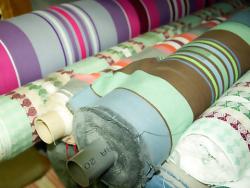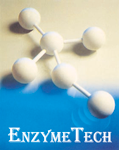- Home
- About Us
- Products
- Enzymology
- Enzyme Applications
- Contact Us
Textiles Processing
Textile processing has benefited greatly on both environmental and product quality aspects through the use of enzymes. Prior to weaving of yarn into fabric, the warp yarns are coated with a sizing agent to lubricate and protect the yarn from abrasion during weaving. Historically, the main sizing agent used for cotton fabrics has been starch because of its excellent film forming capacity, availability, and relatively low cost. Before the fabric can be dyed, the applied sizing agent and the natural non-cellulosic materials present in the cotton must be removed. Before the discovery of amylase enzymes, the only alternative to remove the starch-based sizing was extended treatment with caustic soda at high temperature. The chemical treatment was not totally effective in removing the starch (which leads to imperfections in dyeing) and also results in a degradation of the cotton fiber resulting in destruction of the natural, soft feel, or hand, of the cotton.
The use of amylases to remove starch-based sizing agents has decreased the use of harsh chemicals in the textile industry, resulting in a lower discharge of waste chemicals to the environment, improved the safety of working conditions for textile workers and has raised the quality of the fabric. New enzymatic processes are being developed (cellulase, hemicellulase, pectinase and lipase), which offer the potential to totally replace the use of other chemicals in textile preparation processes.
7.1 Stonewashed Jeans without Stones
Traditionally, to get the look and feel of stonewashed jeans, pumice stones were used. However, thanks to the introduction of cellulase enzymes, the jeans industry can reduce and even eliminate the use of stones. Of course, a big driver for the jeans industry is fashion. Enzymes give the manufacturer a newer, easier set of tools to create new looks.
Although many consumers do not want their jeans to look or feel new, they usually do not want them to look worn-out or torn. The pumice stones used to “stonewash” the denim clothes can also over abrade or damage the garment. By using enzymes, the manufacturer can give consumers the look they want, without damaging the garment.
7.2 Yarn Treatment
In the preparation of cotton yarn for dyeing and garment manufacture, hydrogen peroxide is used to bleach the yarn. Normally, either a reducing agent is used to neutralize the hydrogen peroxide or water is used to rinse out the hydrogen peroxide bleach since it must be removed for proper dyeing. An enzyme, catalase, can be used to breakdown the hydrogen peroxide to water and oxygen. With the use of catalase, the reducing agent can be eliminated or the amount of rinse water can be dramatically reduced, resulting in less polluted wastewater or lower water consumption. Again, enzymes can help us develop sustainable processes by lowering the environmental impact we humans impose. The use of enzymes reduced chemical load, reduced water consumption, lower energy consumption.



